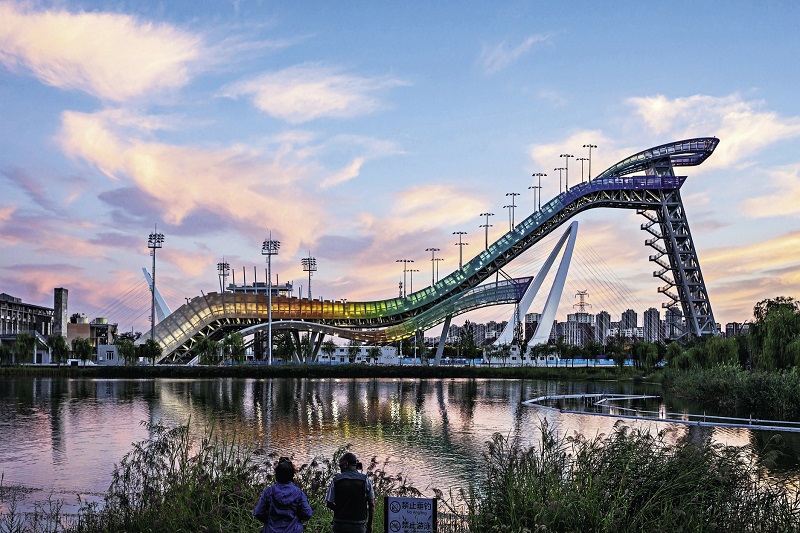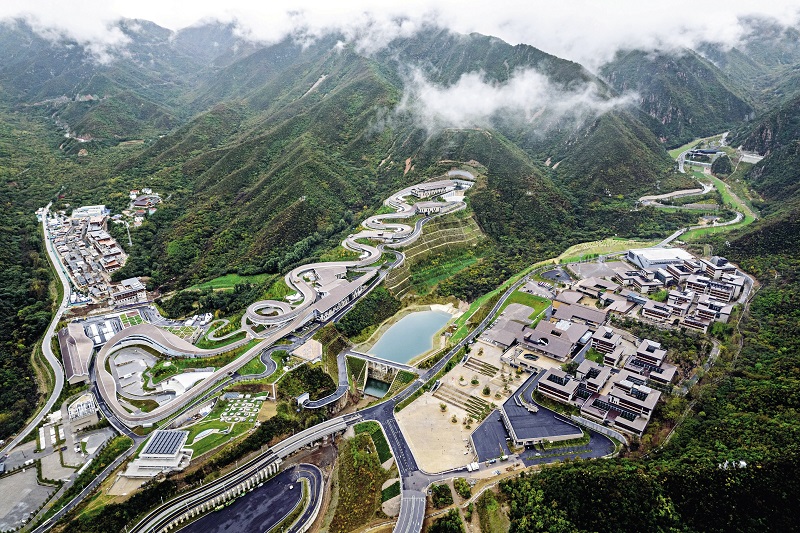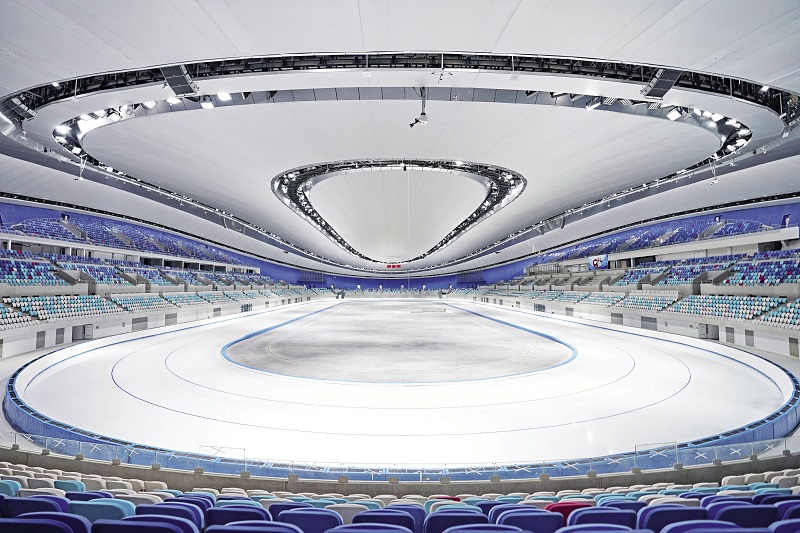The Beijing 2022 Winter Games shine a spotlight on environmentally friendly practices and solutions.

A light show at the Shougang Ski Jumping Platform, the location of the big air event at the Beijing 2022 Olympic Winter Games in Beijing, November 12, 2021.
Four years ago, Beijing took over the flag of the International Olympic Committee (IOC) and the International Paralympic Committee (IPC) at the closing ceremony of the Pyeongchang 2018 Winter Olympic and Paralympic Games, marking the start of the Winter Games’ “Beijing Time.”
The 24th Olympic Winter Games are scheduled to be held from February 4 to 20. The games will consist of seven major events, 15 sub-events, and 109 minor events which will be held in three competition zones, namely Beijing urban area, Yanqing District in Beijing’s northern suburbs, and Zhangjiakou in Hebei Province, a city bordering Beijing. Following the Olympic Winter Games, the Paralympic Winter Games will open on March 4 and close on March 13.
The event will make Beijing the world’s first city to have held both winter and summer Olympic games. During the Summer Olympic Games of 2008, China highlighted the “green Olympics” concept. The country will carry on the legacy in the upcoming Games, but with even greater vigor.
And that’s not just because of the requirements of the Olympic Charter. As the country races toward its ambitious goals of carbon peaking by 2030 and carbon neutrality by 2060, the Games, which will be at the center of domestic and international attention, will be a prime stage for China to showcase its commitment as well as its methods to realize these goals.
Green Venues
Since 2015, the Beijing Organizing Committee for the 2022 Olympic and Paralympic Winter Games (Beijing 2022) has been preparing for the Games, with a focus on the construction of sports venues, which are the foundation for the successful hosting of such a big event.
According to Zhou Guang-hui, chief of safety and quality section of the Beijing Major Projects Construction Headquarters Office, the Games prioritized the use of green construction techniques and built green, low-carbon venues.
China’s National Speed Skating Oval adopts a saddle-shaped, single-layer cable network structure with the largest span of stadium buildings in the world. The tennis racket-shaped huge roof, 198-meter long and 124-meter wide, is built with uniquely light and soft materials, weighing only 25 percent of the traditional roofs, and thereby significantly reducing the amount of materials used and cutting carbon emissions at source.
Meanwhile, the ice at the oval and other three venues for ice sports will be made with an environmentally friendly cooling system that involves the use of carbon dioxide as a refrigerant for the first time with the help of new technology. The new application not only reduces the damage caused by traditional refrigerants to the ozone layer, but also significantly lowers the energy consumption of the refrigeration system, leading to energy savings of more than 30 percent compared with traditional refrigeration methods.
Green building applications such as photovoltaic and photothermal integration are also utilized in the sports venues. The roof of Wukesong Ice Sports Center is installed with a 600 kW photovoltaic power generation system, which can realize an annual power supply of about 700,000 kWh in the future and can meet part of the ice sports center’s electricity demands.
The Winter Olympic Village in Yanqing has installed vacuum tube collectors on the roof, providing more than 70 percent of the total amount of heat for the living areas. The media center there has built its roof using 64 skylights for daylighting and 256 special-shaped photovoltaic panels. The annual power generation capacity is 140,000 kWh, which is equivalent to cutting carbon dioxide emissions by about 90 tons per year.
In addition, venues such as the National Speed Skating Oval have set up energy control centers, which use big data and artificial intelligence analysis to collect, record, and analyze energy consumption data such as water, electricity, gas, and heat in the venues in real time, realizing visual and intelligent monitoring and management of energy consumption and carbon emissions.
“All new indoor venues have reached the three-star standard of green building, which is China’s highest green construction standard, and the existing venues have reached the two-star standard through energy-saving renovation,” Liu Yumin, head of the Planning and Construction Department of Beijing 2022, said.

National Snowmobile and Sled Center located near the Yanqing Winter Olympic Village.
Green Power Supply
From lighting to ice production, electricity represents an indispensable element for the sporting events. To achieve the goal of Green Olympics, the concept of “green electricity” has been introduced. It refers to the utilization of green power resources such as wind, solar, and other renewable energy by transforming them into electricity using special generation equipment.
A number of green power projects and clean energy companies associated with different aspects of electricity generation, transmission, and use for the Games have gained widespread public attention.
Zhangbei, a county of Zhangjiakou, has abundant renewable energy resources, which, however, have not been adequately utilized due to the weak transmission infrastructure. In order to ensure a smooth energy supply for the Games, the Zhangbei flexible direct current (DC) power grid pilot project was built and put into use on June 29, 2020.
“The project uses 12 world-leading technologies to effectively stave off interruption and fluctuation of power supply on the grid, which are typical limitations of new energy sources, and provide stable energy for production and household use,” Xu Zhijun, deputy secretary general of Beijing 2022 organizing committee, said.
For the first time in history, all venues used during the Olympic Games will be exclusively supplied with green energy. This initiative presents a new path for the use and promotion of renewable energy in the future, Xu added.
On December 15, 2020, China Three Gorges Corporation (CTG) became the official power generation partner of the Games.
A CTG wind power farm located in Shangyi County of Zhangjiakou was installed with the capacity of 49.5 MW in Phase I. The project will be connected to the Zhangbei flexible direct current (DC) power grid through a 220 kV line.
These innovative facilities and projects will ensure sufficient supply of green electricity for the winter games. The Zhangbei grid is estimated to provide 22.5 billion kWh of green electricity to Beijing every year, which is about 10 percent of Beijing’s annual electricity consumption, equivalent to saving 7.8 million tons of standard coal and 20.4 million tons of carbon dioxide annually.
Clean energy was also used in previous Olympic Games, but the Beijing Winter Games will power all its venues with a green grid, which is a first in the history of the Olympics, said Juan Antonio Samaranch, chairman of the International Olympic Committee’s Coordination Commission for Beijing 2022. He indicated that this would set a benchmark for the green and sustainable development of all host places and regions.”
Beijing and Hebei Province have also introduced green power trading rules for Winter Olympics venues. China’s State Grid Electric Power Trading Center has established a green power trading process for Winter Olympics venues.

The National Speed Skating Oval is dubbed the “Ice Ribbon.”
Green Transportation
At a press conference on low-carbon operation of the Games held by Beijing 2022 organizing committee on May 26, 2021, Zhao Tong’an, deputy director of the transportation department of the committee, said that during the Games, basically all transportation services will be powered with clean energy, and hydrogen-fueled vehicles will also be promoted.
Hydrogen-fueled vehicles use hydrogen or hydrogen-containing substances to react with oxygen in a fuel cell to generate electricity to power an electric motor, which drives the vehicle. The wide use of hydrogen fuel can effectively reduce air pollution caused by gasoline vehicles.
“We have taken into account various factors such as low temperature and high altitude to maximize the use of energy-saving vehicles in order to reduce carbon emissions. In Yanqing and Zhangjiakou competition areas, we mainly use hydrogen-fueled vehicles,” Zhao said.
In November 2021, hydrogen buses officially started to provide services to the core area of the Yanqing competition area. These buses are equipped with the hydrogen fuel cell engines and eight hydrogen storage cylinders, carrying a total of about 26.4 kg of hydrogen.
These buses can be started in temperatures as low as -30 degrees Celsius, have a design speed of 100 km per hour, and a pure hydrogen range of about 450 km, and can adapt to the conditions of northern cities, featuring low temperatures and sloping roads. Each bus can reduce carbon dioxide emission of 70 km for every 100 km, which is equivalent to the absorption of 14 trees in a day, contributing to the goal of zero emission and zero pollution.
“During this period, the use of the clean-energy vehicles is expected to achieve an emission reduction of about 11,000 tons of carbon dioxide, equivalent to the carbon sink accumulation of more than 50,000 mu (3,333.3 hectares) of forest for one year,” Zhao said, adding that Beijing and Zhangjiakou are building hydrogen refueling stations, charging piles and other supporting facilities as planned to meet the needs of hydrogen-fueled and pure electric vehicles.
All these efforts mean that, when the curtain rises on the 2022 Olympic and Paralympic Winter Games in Beijing, what the world will see is not just the young athletes striving to fulfill their dreams, but also a nation endeavoring to realize a goal that is beneficial for all humankind – that of cutting greenhouse gas emissions and thus mitigating climate change.